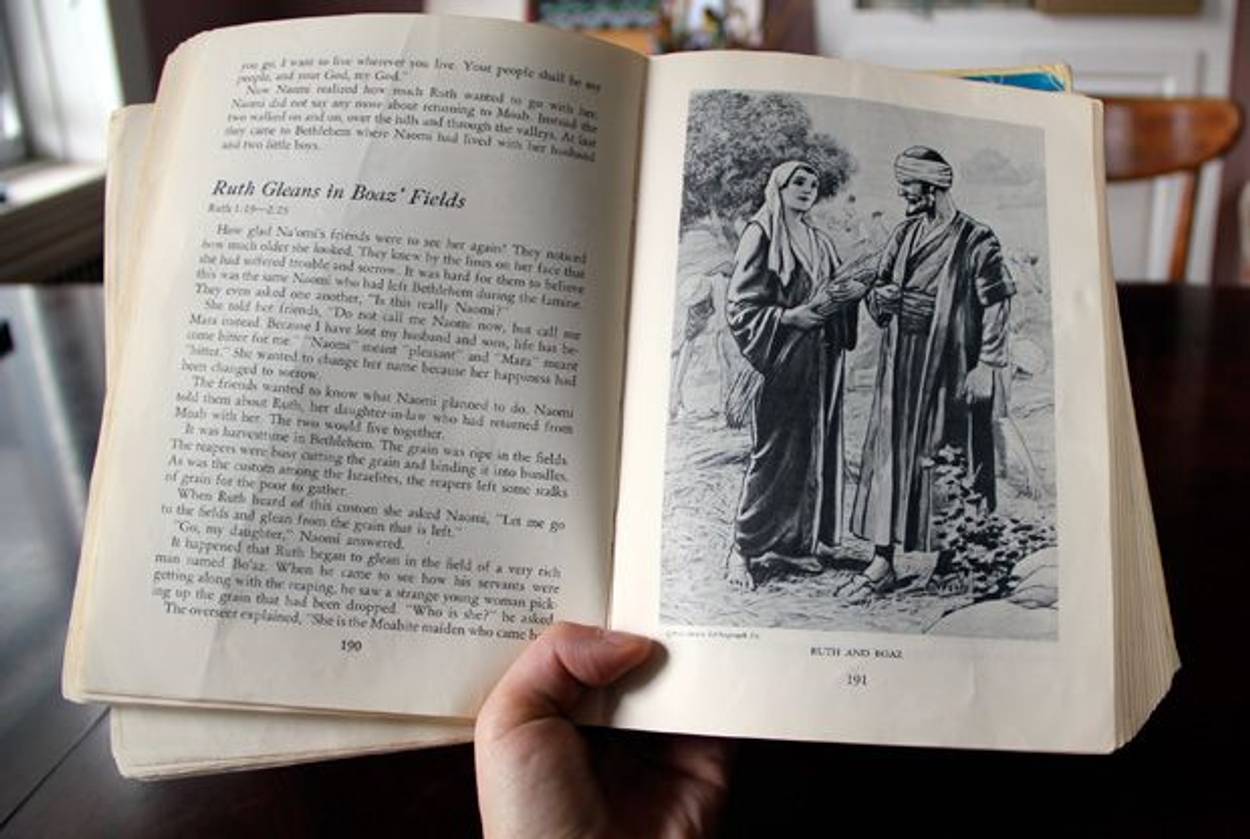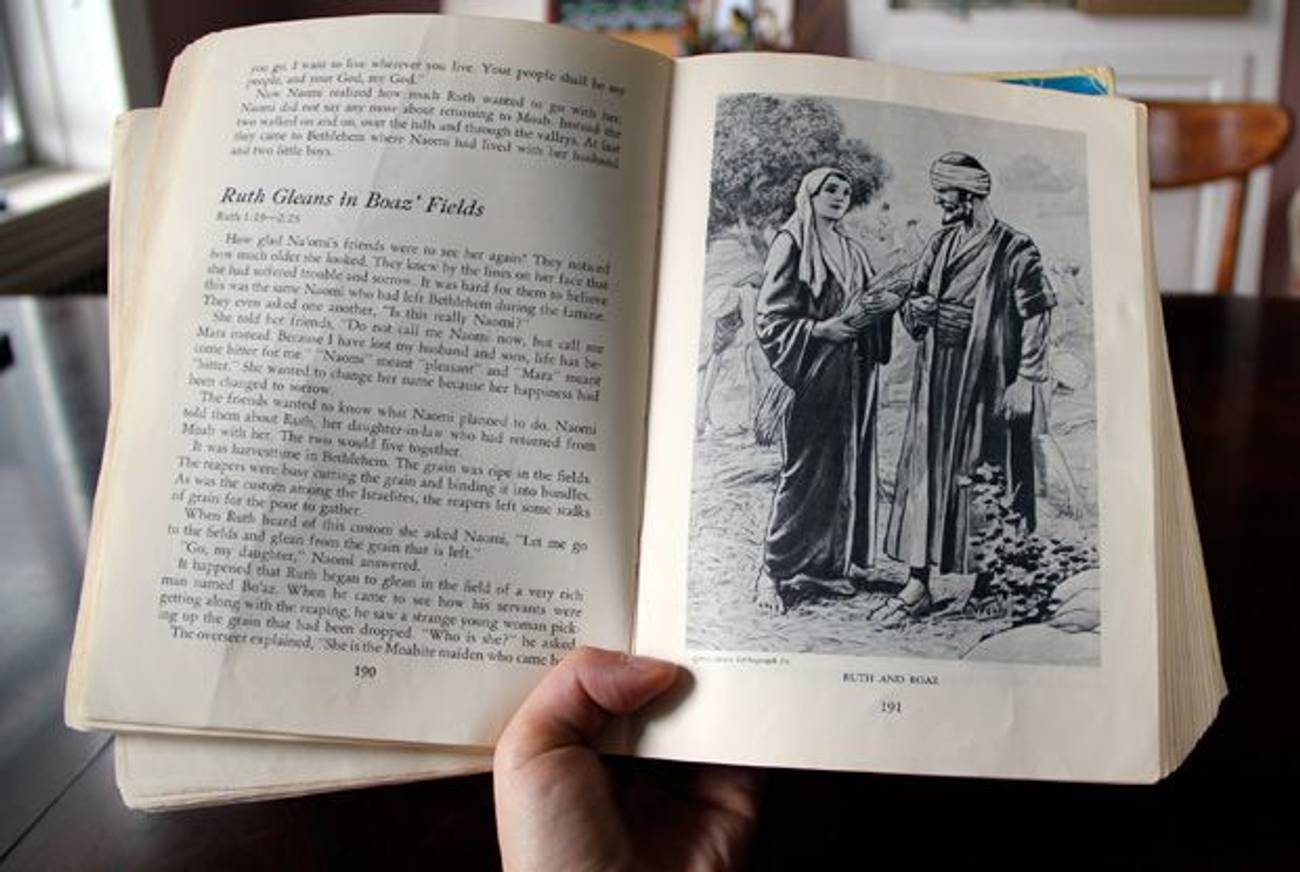A Convert’s Bible Stories: How a Christian Book Introduced Me to Ruth and David
A well-thumbed book from my Lutheran childhood is now the ideal text for my Shavuot study and reflection




Before I began studying to convert to Judaism, Shavuot was totally unknown to me. But once I learned more about it, I saw a number of reasons to view it as the Jewish holiday that converts could celebrate most enthusiastically.
The Book of Ruth, one of the Bible’s best-known conversion stories, is read every Shavuot. As we commemorate the day when the Jews received the Torah, we are told that all Jews throughout history were present at Sinai, no matter what our background or place in history might be—a particularly comforting notion for people who are more recent members of the tribe. And observance of Shavuot includes intense study of Jewish texts, something we converts know a great deal about.
My bookshelves are filled with a range of Jewish books: two long, packed rows containing instructions on Jewish practice, memoirs, all kinds of historical nonfiction, Siddurim, haggadot, various commentaries, copies of the Tanakh and the Torah—all Jewish texts I studied during my conversion process. But there, tucked between my copy of Etz Hayim and my English/Hebrew JPS Tanakh, is a worn and faded volume that would seem to be in the wrong place—a 1955 edition of Egermeier’s Bible Story Book, a collection of narratives from the “Old” and New Testaments, rewritten for children and produced by the Gospel Trumpet Company, a Christian publisher. Despite its history, this non-Jewish text, which I first read decades before my conversion, carries special meaning for me as a convert on Shavuot.
The book is a memento of my childhood in Dayton, Ohio. Some pages include marginalia in youthful handwriting, mostly my younger brother’s. The title page is adorned with a tunic-attired stick figure, drawn by my little sister sometime before she entered kindergarten. The binding is completely broken—a couple of signatures will slide out of the book if it is not opened carefully. Tellingly, when it is closed, one can see that the edges of the pages of the first two-thirds of the book are darker and more worn than the rest. That is because, though the book belonged to my siblings as well as to me, I was the one who spent the most time with it. Throughout my childhood, I returned again and again and again to the stories contained in what I now know as the Tanakh.
From early childhood, I found the stories in the New Testament to be consistently odd and uninspiring. Raised in the Lutheran church, I was taken to Sunday school every week by my parents and sent to vacation Bible school in the summer. In that environment, the greatest praise was reserved for children who knew the New Testament front to back—all the books in order, action and actors, chapter and verse. The goal for all that learning was to make the case for the divinity of Jesus, to affirm the salvation story. I was an excellent student, and I loved to read, to answer teachers’ questions accurately, to show how well I understood a text. But when I read the New Testament, something inside only allowed me to learn it as literature. I repeated back what the teachers wanted to hear, which was easy enough. But I secretly recoiled from accepting the conclusions my instructors insisted on.
But the “Old Testament” plots and characters fascinated me. They filled me with wonder, entered my heart, and sharpened my mind. The structure of Egermeier’s Bible Story Book was an ideal way to encounter this material: narrative only, short sections, descriptive titles, enhanced by theatrical illustrations, and without the parts a child would find “boring.” In the quiet periods that I was able to claim as a child, I would disappear into my bedroom and read the stories obsessively, repeatedly, studying them like a yeshiva bokhur.
Later, when I had children of my own, my father asked me if I wanted the copy of Egermeier’s to pass on to them. But the book was far too fragile to survive another round with young kids, so with my siblings’ blessing, I kept it safely stored away. When I began to study for conversion a few years ago, however, I brought it out again. Though I occasionally winced at the stilted, old-fashioned writing style and melodramatic tone, it provided an opportunity to relive the way the book had formed the relationships I still have with the heroes of the Tanakh, relationships that continue to feel personal, even familial.
As can be true for families in real life, some relationships mean more to me than others. Those relationships include the one I had with Sarah, who, when told she would have the child she had always wanted, laughed, thinking she was too old to have a child. It was an example of not being able to “take yes for an answer”—a phrase I learned much later. But, even as a child I recognized it as a reaction I would probably have myself. I saw Rachel and Leah entwined in a drama that was painful to witness because it was so easy to identify with either woman. It made me uncomfortable in a way I knew was necessary, exposing me to essential truths about human emotion and human behavior. The story of Joseph, on the other hand, was thrilling and almost satisfying. I admired his resiliency, his cunning, and his ability to impose some sort of consequences on his brothers without giving in to a desire for full-blooded revenge. It seemed much more realistic than the Christian rhetoric about forgiveness I had been taught.
But two characters in particular stood out, even when I was a child—two stories that both relate to Shavuot, a holiday I’d never even heard about when I was a child.
I responded to the story of Ruth in a visceral and romantic way from the very first time I read it. Before I had any understanding of the concept of conversion, I felt my heart align with hers in her fierce desire to make her home with the Jewish people. I was astounded by the courage it must have taken to leave behind all she had known before, but her choice made sense in my soul.
And then there was David, my girlhood crush: David the shepherd boy, David the strong and savvy warrior, David the builder, David the flawed but righteous king. No teeny-bopper idol in Tiger Beat magazine could compete. Most of all, I loved David the poet. A weakness of Egermeier’s was that it did not contain my very favorite part of the Bible: the Psalms. So, I kept my RSV Bible at hand to consult after reading about David and gazing at the illustrations of him in Egermeier’s. Without always understanding the literal meaning, I absorbed the feeling of the words of the Psalms and let the pictures they painted surround me. I imagined I could hear his voice, delighting in the landscape, singing praises, seeking protection, or predicting the defeat of his enemies.
Tradition says that David was born and died on Shavuot, and the Bible says that David was a descendant of Ruth, a convert. These are additional reasons that, though Shavuot was completely unfamiliar to me not so long ago, it has now become a holiday I naturally and happily embrace. I belong to the People of the Book, and Shavuot is a holiday of books. So, this year I’m going to spend some time with the book that laid the groundwork for my Jewish life— my faded, tattered copy of Egermeier’s Bible Story Book. Although the publishers likely never intended it, the book has become my own profoundly Jewish text, perfect for Shavuot study and reflection. When I read it, I will relive my first experience of Jewish study. I will picture my small blonde head bent over the text, absorbing a lifetime’s worth of lessons from the stories of my people.
C.A. Blomquist is a writer, editor, and artist who lives in Manhattan.